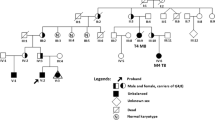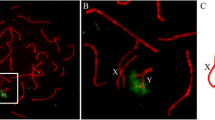Summary
The influence of diabetes on first meiotic segregation behavior in female and male T(1;13) 70H/+mice was studied. By treatment with alloxan 60 mg/kg bodyweight both diabetic and non-diabetic control mice were obtained. All female mice were treated with gonadotropins to obtain reasonable numbers of secondary oocytes per female. As a result of this treatment the number of oocytes ovulated and the percentage that could be analyzed were not different in diabetics and controls, indicating that no severe selection occurred as a result of the diabetic state. Male mice were not treated with gonadotropins, and here the low quality of the air-dried preparations and the scarcity of secondary spermatocytes in diabetics suggest that degeneration occurs. In primary spermatocytes we found higher chiasma frequencies in the translocation multivalent in diabetic males than in controls, probably as a result of reduced chiasma terminalization. The analysis of metaphase-II cells in the females revealed less 3:1 segregation and more adjacent-II segregation in the diabetics. In the males no 3:1 segregation was found in either group, but here adjacent-II segregation was lower in diabetics than in controls. No significant differences were found in nondisjunction frequencies of non-translocation-involved bivalents.
We conclude that diabetes influences the meiotic segregation behavior of chromosomes and that chromosomes showing higher incidences of unbalanced segregation behavior (i.e., multivalent involved chromosomes) are more susceptible to this influence than other chromosomes. In the diabetic males this influence is undone by the severe selection, affecting primarily the cells, that would give rise to unbalanced metaphase II cells, resulting in even lower frequencies of adjacent-II segregation than in controls.
Similar content being viewed by others
References
Biggers JD, Whittingham DG, Donahue RP (1967) The pattern of energy metabolism in the mouse oocyte and zygote. Proc Natl Acad Sci USA 58:560–567
Boer P de (1976) Male meiotic behaviour and male and female litter size in mice with the T(2;8) 26H and T(1;13) 70H reciprocal translocations. Genet Res Camb 27:369–387
Boer P de, Hoeven FA van der (1980) The use of translocation-derived “marker-bivalents” for studying the origin of meiotic instability in female mice. Cytogenet Cell Genet 26:49–58
Champlin AK (1971) Suppression of oestrus in grouped mice: The effects of various densities and the possible nature of the stimulus. J Reprod Fertil 27:233–241
Chieri RA, Pivetta OH, Foglia VG (1969) Altered ovulation pattern in experimental diabetes. Fertil Steril 20:661–666
Cusan L, Bélanger A, Séquin C, Labrie F (1980) Impairment of pituitary and gonadal functions in alloxan-induced diabetic male rats. Molec Cell Endocrinol 18:165–176
Deb C, Chatterjee A (1963) Role of ascorbic acid on testicular degeneration in alloxan diabetic rats. Experientia 19:595–596
Endo A, Ingalls TH (1968) Chromosomal anomalies in embryos of diabetic mice. Arch Environ Health 16:316–325
Evans EP, Breckon C, Ford CE, (1964) An air-drying method for meiotic preparations from mammalian testes. Cytogenetics 3:289–294
Forbes AP, Engel E (1963) The high incidence of diabetes mellitus in 41 patients with gonadal dysgenesis, and their close relatives. Metabolism 12:428–439
Golbus MS (1981) The influence of strain, maternal age, and method of maturation on mouse oocyte aneuploidy. Cytogenet Cell Genet 31: 84–90
Goldman JA (1974) Carbohydrate metabolism in fathers of babies with congenital malformations. Isr J Med Sci 10:698–701
Grootegoed JA, Jutte NHPM, Jansen R, Heusdens FA, Rommerts FFG, Molen HJ van der (1981) Biochemistry of spermatogenesis. The supporting role of Sertoli cells. Proceedings of the Xth meeting of the International Study Group for Steroid Hormones, Rome
Hillensjö T, LeMaire WJ (1980) Gonadotropin releasing hormone agonists stimulate meiotic maturation of follicle-enclosed rat oocytes in vitro. Nature 287:145–146
Horii K, Watanabe G, Ingalls TH (1966) Experimental diabetes in pregnant mice. Prevention of congenital malformations in offspring by insulin. Diabetes 15:194–204
Milunsky A (1970) Glucose intolerance in the parents of children with Down's syndrome. Am J Ment Defic 74:475–478
Navarrete VN, Torres IH, Rivera IR, Shor VP, Grácia PM (1967) Maternal carbohydrate disorder and congenital malformations. Diabetes 16:127–130
Nielsen J (1972) Diabetes mellitus in patients with aneuploid chromosome aberrations and in their parents. Humangenetik 16:165–170
Nijhoff JH, Boer P de (1980) Radiation-induced meiotic autosomal nondisjunction in male mice. The effects of low doses of fission neutrons and X-rays in meiosis I and II of a Robertsonian translocation heterozygote. Mutat Res 72:431–446
Nijhoff JH, Boer P de (1981) Spontaneous meiotic non-disjunction in mammals. A study evaluating the various experimental approaches. Genetica 56:99–121
Oud JL, Jong JH de, Rooij DG de (1979) A sequential analysis of meiosis in the male mouse using a restricted sparmatocyte population obtained by a hydroxyurea/triaziquone treatment. Chromosoma 71:237–248
Peters FD, Roemer VM (1977) Diabetes mellitus und Schwangerschaft. Theorie und Praxis. Geburtshilfe Frauenheilkd 37:557–565
Rerup CC (1970) Drugs producing diabetes through damage of the insulin secreting cells. Pharmacol Rev 22:485–518
Rubin A, Murphy DP (1958) Studies in human reproduction. III. Frequency of congenital malformations in offspring of non-diabetic and diabetic individuals. J Pediatr 53:579
Schöffling K, Ferderlin K, Ditschuneit H, Pfeiffer EF (1963) Disorders of sexual function in male diabetics. Diabetes 12:519–527
Shipley EG, Danley KS (1947) Pituitary and ovarian dysfunction in experimental diabetes. Am J Physiol 150:84–94
Sumner AT (1972) A simple technique for demonstrating centromeric heterochromatin. Expl Cell Res 75:304–306
Tarkowski AK (1966) An air-drying method for chromosome preparations from mouse eggs. Cytogenetics 5:394–400
Tollinger CD, Chrisman CL, Doolittle DP (1974) Alloxan-induced aneuploidy in mice. J Hered 65:345–348
Watanabe G, Ingalls TH (1963) Congenital malformations in the offspring of alloxan-diabetic mice. Diabetes 12:66–72
Yamamoto M, Endo A, Watanabe G (1971) Chromosomal aneuploidies and polyploidies in embryos of diabetic mice. Arch Environ Health 22:468–475
Author information
Authors and Affiliations
Rights and permissions
About this article
Cite this article
Wauben-Penris, P.J.J., Prins, J.B. Meiotic behavior of alloxan-treated diabetic and nondiabetic T(1;13) 70H/+mice. Hum Genet 63, 268–273 (1983). https://doi.org/10.1007/BF00284662
Received:
Issue Date:
DOI: https://doi.org/10.1007/BF00284662




